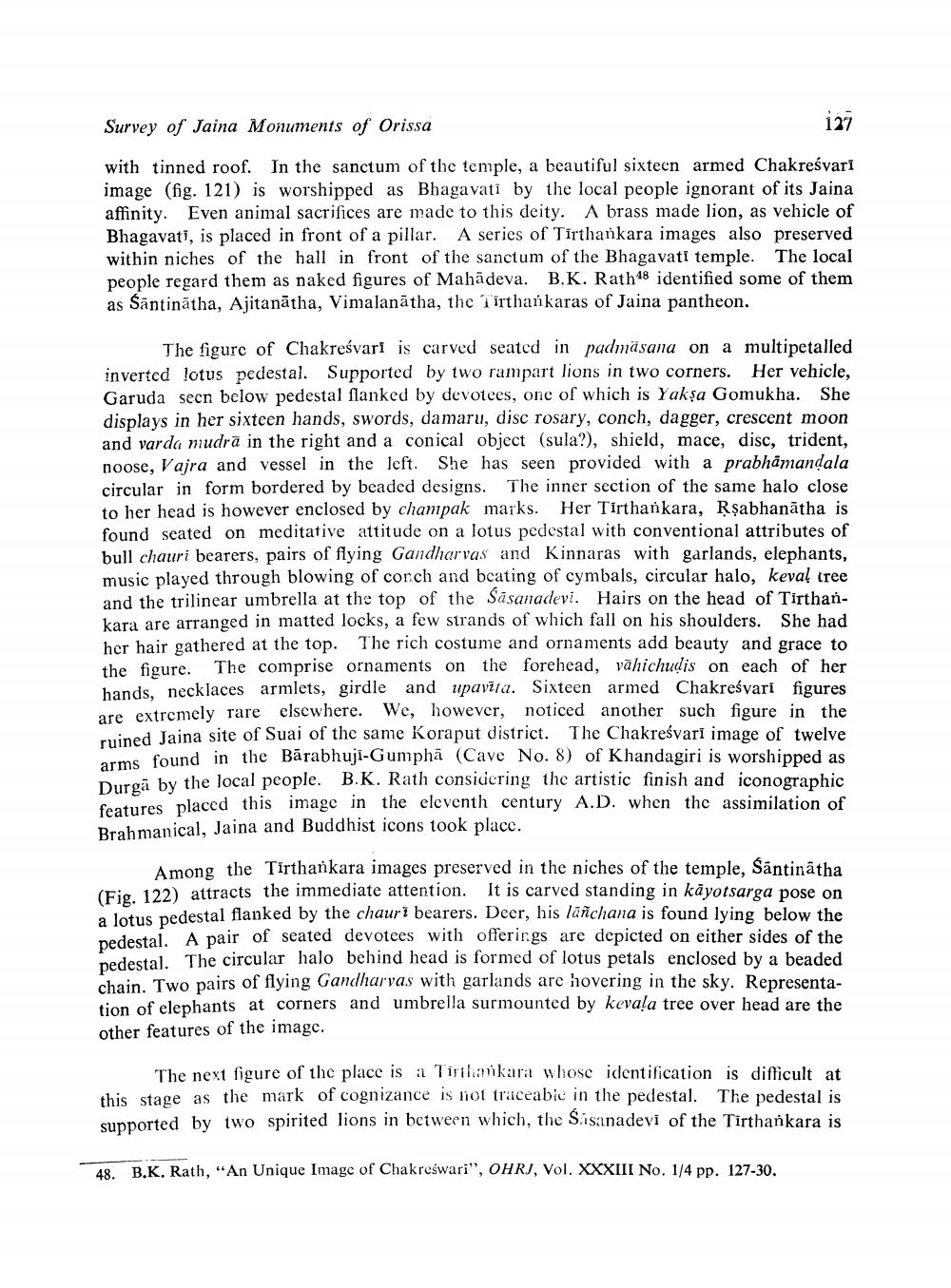________________
Survey of Jaina Monuments of Orissa
i27
with tinned roof. In the sanctum of the temple, a beautiful sixteen armed Chakreśvari image (fig. 121) is worshipped as Bhagavatî by the local people ignorant of its Jaina affinity. Even animal sacrifices are made to this deity. A brass made lion, as vehicle of Bhagavati, is placed in front of a pillar. A series of Tirthankara images also preserved within niches of the hall in front of the sanctum of the Bhagavati temple. The local people regard them as naked figures of Mahadeva. B.K. Rath48 identified some of them as Santinätha, Ajitanātha, Vimalanātha, the Tirthakaras of Jaina pantheon.
The figure of Chakreśvari is carved seated in padmasana on a multipetalled inverted lotus pedestal. Supported by two rampart lions in two corners. Her vehicle, Garuda seen below pedestal flanked by devotees, one of which is Yakşa Gomukha. She displays in her sixteen hands, swords, damaru, disc rosary, conch, dagger, crescent moon and varda mudra in the right and a conical object (sula?), shield, mace, disc, trident, noose, Vajra and vessel in the left. She has seen provided with a prabhamandala circular in form bordered by beaded designs. The inner section of the same halo close to her head is however enclosed by champak marks. Her Tirthankara, Rşabhanātha is found seated on meditative attitude on a lotus pedestal with conventional attributes of bull chauri bearers, pairs of flying Gandharvas and Kinnaras with garlands, elephants, music played through blowing of conch and bcating of cymbals, circular halo, keval tree and the trilinear umbrella at the top of the Sasanadevi. Hairs on the head of Tirthankara are arranged in matted locks, a few strands of which fall on his shoulders. She had her hair gathered at the top. The rich costume and ornaments add beauty and grace to the figure. The comprise ornaments on the forehead, vāhichudis on each of her hands. necklaces armlets, girdle and upavita. Sixteen armed Chakreśvari figures are extremely rare elsewhere. We, however, noticed another such figure in the Svined Jaina site of Suai of the same Koraput district. The Chakreśvari image of twelve arms found in the Bārabhuji-Gumphā (Cave No. 8) of Khandagiri is worshipped as Turon by the local people. B.K. Rath considering the artistic finish and iconographic features placed this image in the eleventh century A.D. when the assimilation of Brahmanical, Jaina and Buddhist icons took place.
Among the Tirthankara images preserved in the niches of the temple, Santinatha (Fig. 122) attracts the immediate attention. It is carved standing in kāyotsarga pose on
Intus pedestal flanked by the chauri bearers. Deer, his lāñchana is found lying below the pedestai. A pair of seated devotees with offerirgs are depicted on either sides of the Bedestal. The circular halo behind head is formed of lotus petals enclosed by a beaded Chain Two pairs of flying Gandharvas with garlands are hovering in the sky. Representation of elephants at corners and umbrella surmounted by kevala tree over head are the other features of the image.
The next figure of the place is a Tirilankara whose identification is difficult at this stage as the mark of cognizance is not traceabic in the pedestal. The pedestal is supported by two spirited lions in between which, the Sisanadevi of the Tirthankara is
48. B.K. Rath, "An Unique Image of Chakreśwari", OHRI, Vol. XXXIII No. 1/4 pp. 127-30.




